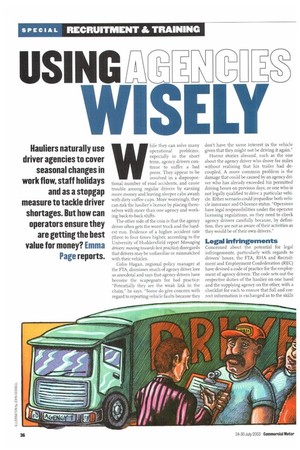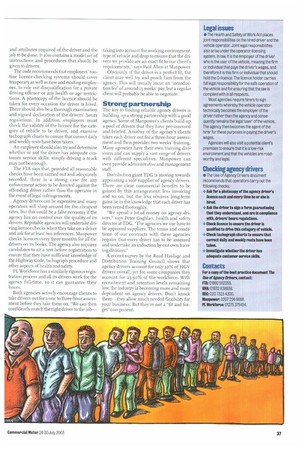SEIX
Page 36

Page 37

If you've noticed an error in this article please click here to report it so we can fix it.
MI!hile they can solve many operational problems, especially in the short term, agency drivers continue to suffer a bad press. They appear to be involved in a disproportional number of road accidents, and cause trouble among regular drivers by earning more money and leaving sleeper cabs awash with dirty coffee cups. More worryingly, they can risk the haulier's licence by placing themselves with more than one agency and working back-to-back shifts.
The other side of the coin is that the agency driver often gets the worst truck and the hardest run. Evidence of a higher accident rate (three to four times higher, according to the University of Huddersfield report Managing drivers: moving towards best practice) disregards that drivers may be unfamiliar or mismatched with their vehicles.
Colin Hagan, regional policy manager at the FTA, dismisses much of agency driver lore as anecdotal and says that agency drivers have become the scapegoats for bad practice: "Potentially they are the weak link in the chain," he says. "Some do give concern with regard to reporting vehicle faults because they don't have the same interest in the vehicle given that they might not be driving it again."
Horror stories abound, such as the one about the agency driver who drove for miles without realising that his trailer had decoupled. A more common problem is the damage that could he caused by an agency driver who has already exceeded his permitted driving hours on previous days, or one who is not legally qualified to drive a particular vehicle. Either scenario could jeopardise both vehicle insurance and 0-licence status. "Operators have legal responsibilities under the operator licensing regulations, so they need to check agency drivers carefully because, by definition, they are not as aware of their activities as they would be of their own drivers."
Legal infringements
Concerned about the potential for legal infringements, particularly with regards to drivers' hours, the FTA, RHA and Recruitment and Employment Confederation (REC) have devised a code of practice for the employment of agency drivers. The code sets out the respective duties of the haulier on one hand and the supplying agency on the other, with a checklist for each to ensure that full and correct information is exchanged as to the skills and attributes required of the driver and the job to be done. It also contains a model set of instructions and procedures that should be given to drivers.
The code recommends that employers' routine licence-checking systems should cover temporary as well as new and existing employees, to rule out disqualification for a private driving offence or any health or age restrictions. A photocopy of the licence should be taken for every occasion the driver is hired. There should also be a thorough examination and signed declaration of the drivers' hours regulations. In addition, employers must check the validity of the licence for the category of vehicle to be driven, and examine tachograph charts to ensure that correct daily and weekly rests have been taken.
An employer should also try and determine whether or not the driver has adequate customer service skills: simply driving a truck may not be enough.
The FTA says that, provided all reasonable checks have been carried out and adequately recorded, there is a strong case for any enforcement action to be directed against the offending driver rather than the operator in the event of legal infringements.
Agency drivers can be expensive and many operators will shop around for the cheapest rates, but this could be a false economy if the agency has no control over the quality of its drivers. Reputable agencies will undertake driving licence checks when they take on a driver and ask for at least two references. Manpower checks licences every three months for all the drivers on its books. The agency also requires candidates to sit a test before registration to ensure that they have sufficient knowledge of the Highway Code, tachograph procedure and other aspects of health and safety.
PL Workforce has a similarly rigorous registration process and all its drivers work for the agency full-time, so it can guarantee their hours.
Both agencies actively encourage clients to take drivers out for a one to three-hour assessment before they take them on. "We can then confidently match the right driver to the job—
taking into account the working environment, type of vehicle and drop to ensure that the drivers we provide are an exact fit to our client's requirements," says Paul Allen at Manpower.
Obviously, if the driver is a perfect fit, the client may well try and poach him from the agency. This will usually incur an 'introduction fee' of around 13 weeks' pay, but a regular client will probably be able to negotiate.
Strong partnership
The key to finding reliable agency drivers is building up a strong partnership with a good agency. Some of Manpower's clients build up a pool of drivers that they have pre-assessed and briefed. Another of the agency's clients takes each driver out for a three-hour assessment and then provides two weeks' training. Many agencies have their own training divisions and can supply a vast range of drivers with different specialities. Manpower can even provide administrative and management staff.
Distribution giant TDG is moving towards appointing a sole supplier of agency drivers. There are clear commercial benefits to be gained by this arrangement: less invoicing and so on, but the less obvious long-term gains lie in the knowledge that each driver has been vetted thoroughly.
"We spend a lot of money on agency drivers," says Peter Coghlan, health and safety director at TDG. "The agencies we use have to be approved suppliers. The terms and conditions of our contracts with these agencies require that every driver has to be assessed and undertake an induction by our own training division."
A recent survey by the Road Haulage and Distribution Training Council shows that agency drivers account for only o% of HGV drivers overall, yet for some companies they account for 23-30% of the workforce. With recruitment and retention levels remaining low, the industry is becoming more and more dependent on agency drivers. Don't knock them—they allow much needed flexibility for your business. But they're not a "fit and forget" component.




























































































































































